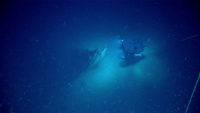 The wreck of a wooden ship from the mid-19th century has been discovered in the Gulf of Mexico entirely by accident. The crew of the National Oceanic and Atmospheric Administration’s (NOAA) Okeanos Explorer wasn’t looking for shipwrecks on the May 16th dive. They were testing Deep Discoverer, a new remotely operated vehicle, and it more than lived up to its name when its sonar detected something shaped like a shipwreck. That something was a shipwreck.
The wreck of a wooden ship from the mid-19th century has been discovered in the Gulf of Mexico entirely by accident. The crew of the National Oceanic and Atmospheric Administration’s (NOAA) Okeanos Explorer wasn’t looking for shipwrecks on the May 16th dive. They were testing Deep Discoverer, a new remotely operated vehicle, and it more than lived up to its name when its sonar detected something shaped like a shipwreck. That something was a shipwreck.
Unprepared for an impromptu archaeological survey, researchers called and emailed marine archaeologists to follow Deep Discoverer‘s exploration remotely via live stream video. The dive was extended an additional three hours to give the archaeologists an opportunity to get a more thorough look at the site.
Those who joined the live stream suspect that the wreck is that of a sailing vessel built sometime in the mid-19th century, perhaps a schooner or brig, measuring roughly 37.8 meters (124 feet) long. The vessel is wooden with copper sheathing covering the bottom of its hull. Experts were able to infer the time period of the vessel’s origination based on a number of construction features, including the form of the stem and bow, the body of the hull, and the remains of the windlass. However, this information does not indicate the age of the vessel at the time it was lost, which could have been decades later. Initial observations also noted copper and iron artifacts at the site, but no diagnostic artifacts reflecting the vessel’s rig, trade, nationality, or crew were identified during the dive.
The hull remains are more or less intact up to the water line, with its timber protected by the sheathing. Some of the sheathing has deteriorated and fallen off the hull, leaving only the edges of each copper plate where they were tacked or nailed to the hull. However, all structure above the waterline is missing, and during the initial observations of the dive, there did not appear to be many traces of the standing rigging. Furthermore, a number of timbers appeared charred and some of the fasteners were bent, which may be an indication of burning. While the evidence is still being assessed, it is possible that this sailing vessel caught fire and was nearly completely consumed before sinking. This may explain the lack of artifacts from the rigging, decks, and upper works, as well as the lack of personal possessions.
 The surviving section of the rudder has copper numbers “2109” nailed to it as are the remains of the copper sheathing. Where the copper sheathing remains attached to the hull it is still doing the job it was intended to do: keeping marine life from setting up shop on the wood. The barnacles and shipworm that have attached themselves to the rest of the ship avoid the copper areas.
The surviving section of the rudder has copper numbers “2109” nailed to it as are the remains of the copper sheathing. Where the copper sheathing remains attached to the hull it is still doing the job it was intended to do: keeping marine life from setting up shop on the wood. The barnacles and shipworm that have attached themselves to the rest of the ship avoid the copper areas.
The ROV has recorded extensive high-definition video of the wreck. It will be used to create a photomosaic of the site in extremely high resolution that will allow experts around the world to examine the wreck in much greater detail. This is the low-res version, believe it or not:
And here’s some of the footage of the wreck taken by Deep Discoverer:

Does anyone know what the numbers ‘2109’ might refer to? Cargo tonnage?
What the numbers ‘2109’ might refer to, you ask?
—————–
“Next technical inspection: September, 1821”
:hattip:
:yes:
My first thought was a piracy victim.